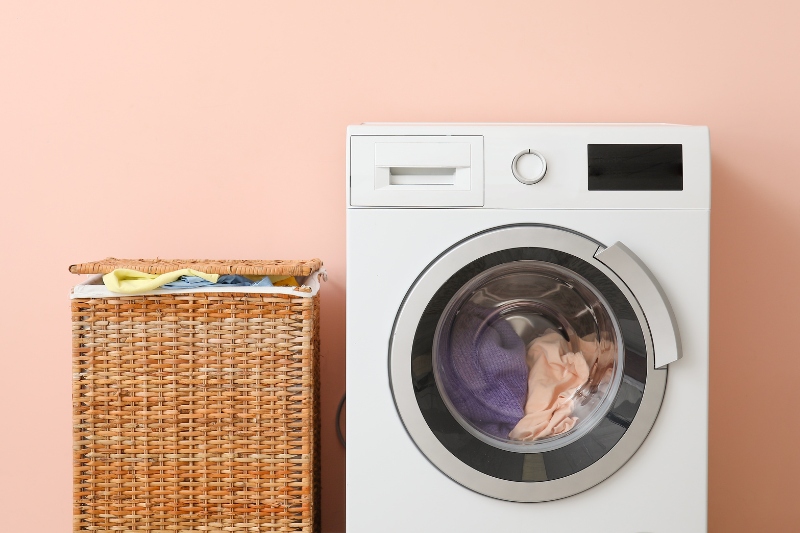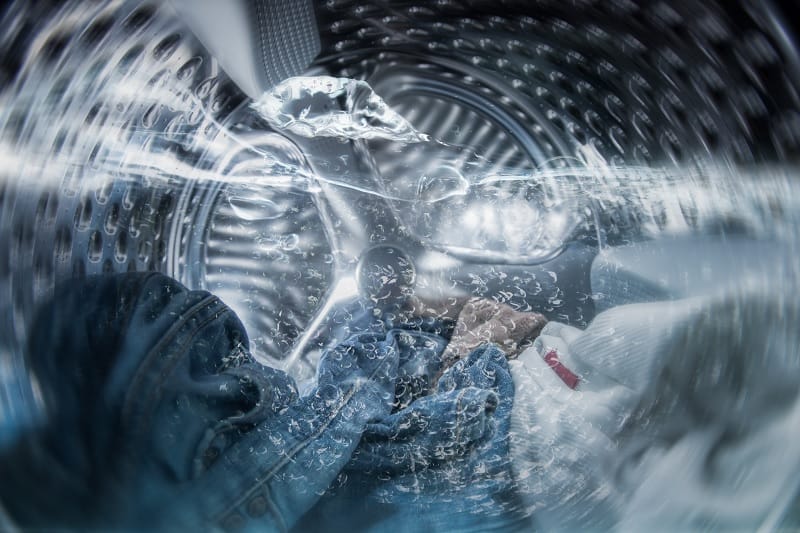Deciding where to put a washing machine can be difficult! Should it go in the kitchen? What about in the garage? Or even in the bathroom?
The truth is, there’s no single ‘correct’ place to put a washing machine.
There are, however, certain conditions you’ve got to meet before you can set up your washer. There needs to be the necessary pipework in place for water and drainage purposes, as well as access to electricity. Obviously, you also need to choose a safe place for the appliance.
Learn more about where to place a washing machine below.
Can a Washing Machine Go Anywhere?
A washing machine can be housed in several places in a home, as long as:
- You’ve got the right plumbing and electricity in place.
- The appliance has sufficient space.
- You can cover the cost of any home improvements that may need to be made.
- You adhere to any government guidelines that may be applicable.
Let’s take a look at these points in more detail.
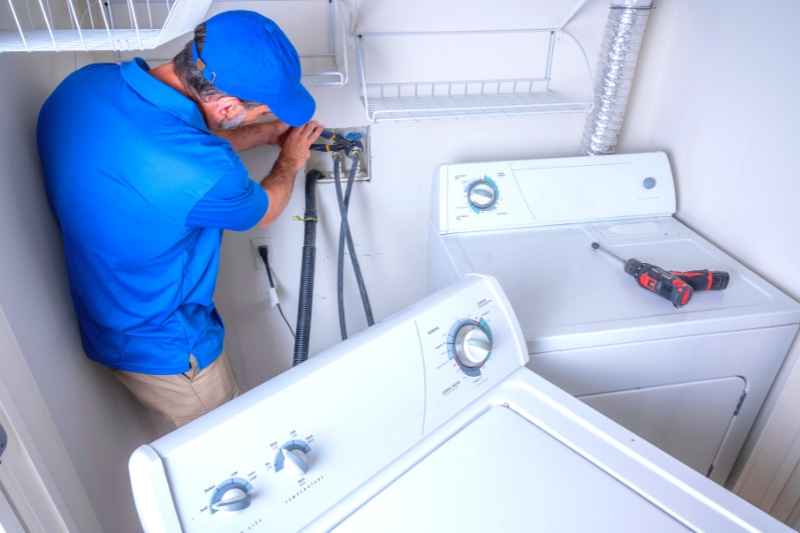
Plumbing and electricity
A washing machine needs power and water to function, so you need to place it near an electricity socket and a water and drainage pipe.
In a lot of homes in the UK, these hook-up points are commonly found in kitchens and utility rooms and are normally near an exterior wall.
All you need to do is hook your washer up to the water and electricity supplies, and the machine will work.
If you don’t have access to water or electricity, you’ll have to ask a plumber and an electrician for help. There is usually a cost involved with adding these connections.
So, if you want to keep costs down, try and use the connections that you’ve already got available, or put the new connections near pre-existing plumbing points.
It’s not ideal to put plumbing points in a bedroom for example, because there are no plumbing features in this type of room normally.
Space
A washing machine is a large, boxy appliance that isn’t the easiest of machines to move about.
So, the last thing you want to do is stuff the washer into a tiny cupboard, and you can’t get it out easily to inspect, clean, and repair it.
Think about what space you have available, and buy a washing machine that’ll fit into the spot you’ve allocated to the machine first of all.
Consider if you’d be able to maintain the machine when it’s housed in that space. If you’re not able to take the appliance out of its designated spot with ease, there’s no point putting it there.
In addition to the physical space needed to house the washer, you need to leave enough room for air to circulate the appliance.
If air is unable to circulate around the machine, mould and damp-related troubles can occur. This can normally be sorted out, but it’s better to avoid such an occurrence in the first place.
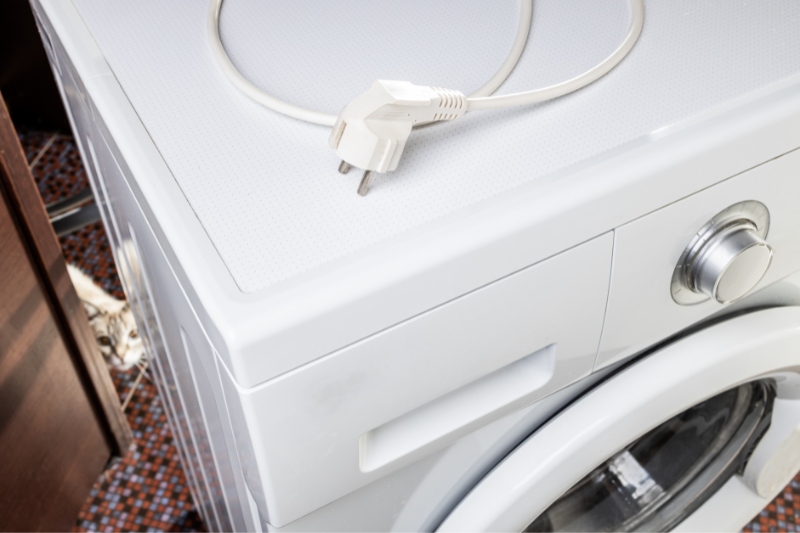
Home improvements and costs
Although it’s possible to place a washer virtually anywhere in a home, as mentioned above, if you don’t have the right connections in place your washing machine will not function.
One way to alleviate this problem is to add the right connections to your home. However, it’s not as easy as you think to add these supply points to random rooms in an abode, and it often comes with a hefty price tag.
This is why it’s better if you try and place your washer near pre-existing water outlets, like near a sink or in a purpose-built utility room, so that you don’t have to carry out too much plumbing/electricity work.
If you have to remodel your home to accommodate a washer, then you must be prepared to cover any extra costs that you might have to pay out for, like remodelling a space or knocking down a wall.
Further to the above, it’s not uncommon for people to want to house washing machines in cupboards or wardrobes.
This isn’t a big problem, but you do have to factor in the cost of modifying your home by adding the right plumbing points and electricity sockets to said cupboard/wardrobe.
You’ll also have to think about how you can ventilate the space, and if you need to reinforce the floor. All of which can be pricey to carry out.
Similarly, if you plan on putting a washer in a garage or shed you have to think about the temperature difference and how this can affect the machine.
Colder temperatures (especially under 5°C) have been known to damage washing machines and too hot a temperature can also harm washers.
So, you’ll likely have to renovate your shed/garage and make it warmer/cooler/watertight/level/reinforced, so the washer can function properly. Again, this is an additional cost that needs to be considered.
Rules and regulations
Before you decide to stick your washing machine in a random spot in your home, have a quick look at some UK government guidelines to get their take on where you can put electricity sockets in your abode.
Given the fact that your washing needs power to work, you must put it near a power outlet. However, here in the UK, there are rules and regulations on where you can place sockets.
One of these rules is that you cannot put an electricity socket within three metres of a shower or bath.
So, unless you have a sufficient amount of space in your bathroom, you will not be able to house a washer in there because there won’t be an electricity point for you to use.
This regulation does differ in other countries, which is why you see homes abroad with washers in the bathroom.

Safety first
It’s also imperative that you place your washing machine in a safe place.
So, although you can technically put the washer anywhere where there is power and water, and doesn’t break any rules, there are some places that are more suitable than others.
You wouldn’t, for example, put a washer in a living room or a bedroom. Not only will the appliance be extremely noisy, but the machine is a literal hazard that someone could walk into and hurt themselves on in the middle of the night.
Practicalities
Although the above points are the most important ones to consider, it’s also worth remembering that you will probably have to move the appliance yourself when it’s in your home. So, the idea of ‘putting the washer anywhere’ might be a little impractical, to say the least!
It’s not necessarily the best idea to put a washing machine upstairs, for example, because you might not be able to get it up the stairs by yourself.
So, you really must think about how practical it is to move a washer to a random spot in a home.
Washing machines aren’t light. In fact, most versions of this machine are incredibly heavy, so the last thing you want to be doing is lugging the appliance back and forth and ‘testing out’ new homes for it.
It’s also dangerous to move this type of appliance up and down the stairs if you don’t know how to do it properly. You could seriously hurt yourself.
It’s much easier if you put the machine in a safe and comfortable place for it and for you!
A quick recap of the main points:
- You must have the correct plumbing in place, as well as an electricity socket.
- It can work out costly to add the right plumbing and electricity points to a home.
- It can be costly to remodel or repurpose spaces.
- You need to think about the practicalities of moving a washer around a home – it’s not easy work.
- You have to adhere to rules and regulations first and foremost.
- You need to have enough room to house the washer in a particular place and this space needs to have good ventilation.
- It’s unwise to stick a washer in a random space because it can be a hazard!
Where Can a Washing Machine Be Placed?
There are plenty of places where a washing machine can go in a home. Nonetheless, there are more preferable spots to house such an appliance and less favourable areas too.
Kitchen
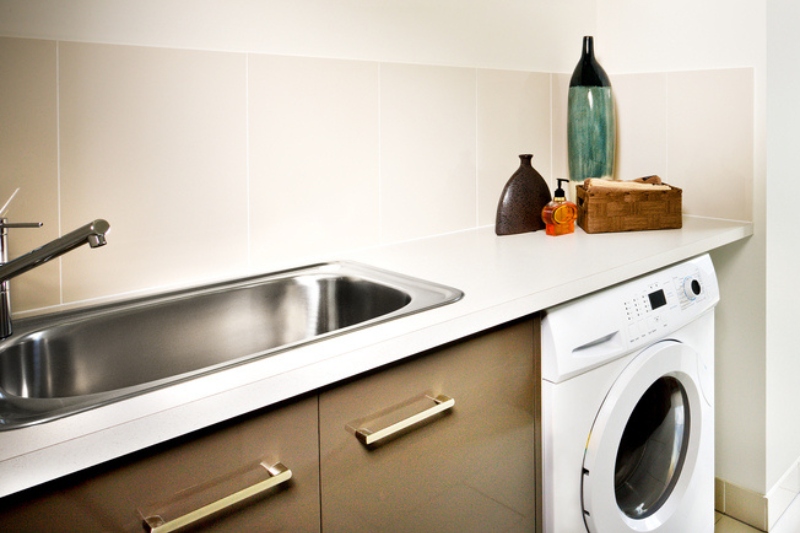
Washing machines are typically placed in kitchens because the connections are already in place here (plumbing and electric socket). There’s usually no need, unless something is broken, for someone to tamper with the connections.
And, in general, all you need to do is connect the water pipe, ensure the hose is set up correctly, and pop the plug in the socket. The machine normally springs to life when you do this.
There are several locations within a kitchen where you could put a washing machine, including under the worktop, in a cupboard, or in a pantry.
Utility room
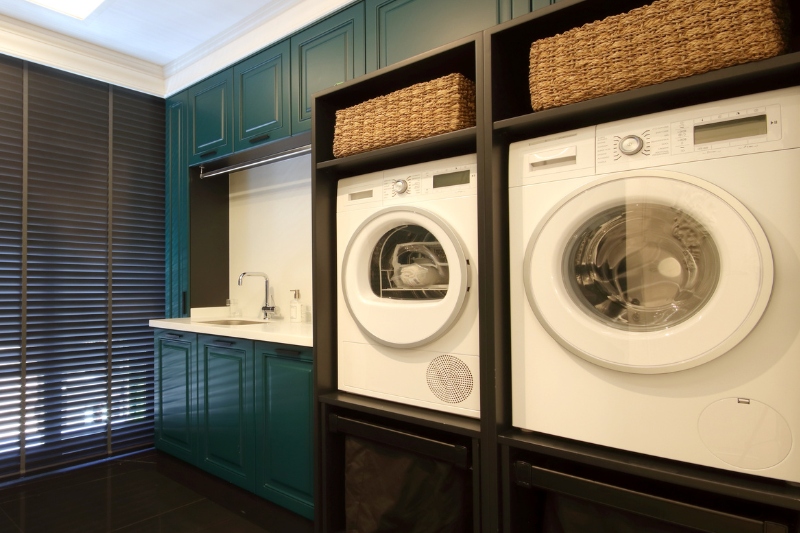
In a utility room you’ll normally be able to keep both a washer and a dryer, so you can quickly transfer the laundry from one machine to another with ease.
Utility rooms often have windows, are near the back door, and have extractor fans in them, so the machines have access to good ventilation.
Garage, shed or outbuildings
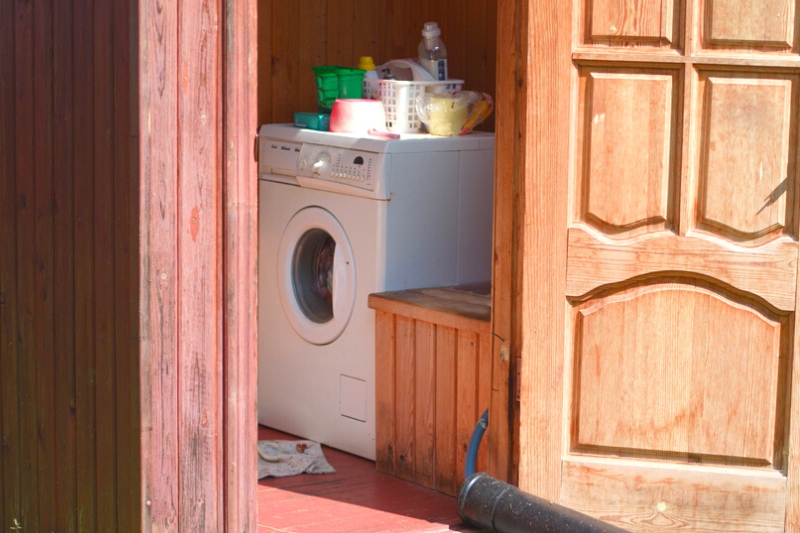
If you’re short on space indoors then keeping your washer in a shed/outhouse/garage is a backup option. It’s generally not a bad idea to do this, but you must make the environment ‘washing machine friendly’.
For example, you need to make sure the ambient temperature in the area doesn’t drop too much so that the machine starts to freeze/overheat, and you must level the floor.
If you’re able to carry out these kinds of improvements you’ll have freed up some space in your home, and you can relax knowing your washer is safe elsewhere!
Places to Avoid Putting a Washing Machine
Here are some places you should avoid putting a washing machine in.
Bedrooms
It’s not practical to place a washer in a bedroom because you don’t usually have the right connections in the room to start with. Also, the machine is so big, you could seriously hurt yourself if you walked into it at night.
Plus, the machine can be noisy! This, in turn, could be very disruptive for someone who’s trying to sleep in the room when the washer is on.
In addition to this, bedrooms are not usually huge spaces, so having a washer in an already packed room might increase the chances of mould because there’s a lack of good ventilation.
Bathrooms
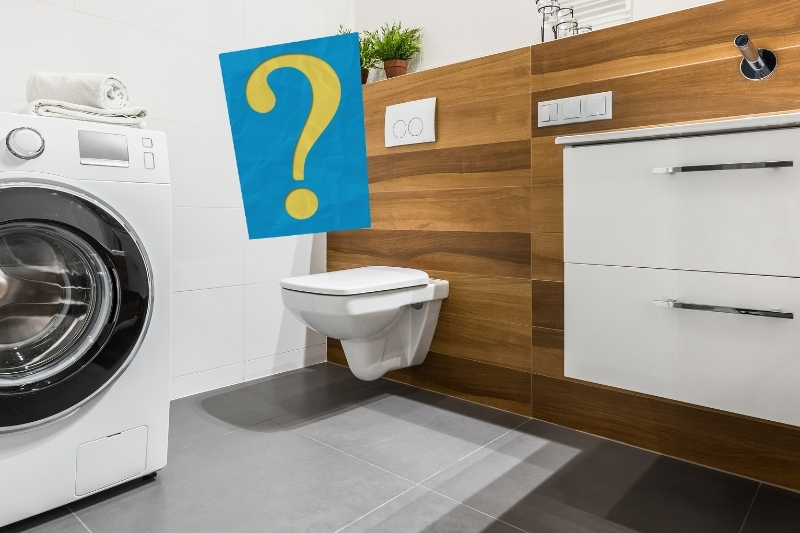
Unless you have at least three metres between a bath/shower and where you’d like to place an electricity socket, you won’t be able to add the socket to the room.
In addition to this, bathrooms are hot and damp environments, and they’re not always well-ventilated spaces. This isn’t a great environment for your washing machine to be put in! This could cause issues for the washer itself, and the increased moisture in the air could lead to bigger mould/damp-related issues.
Living room or dining room
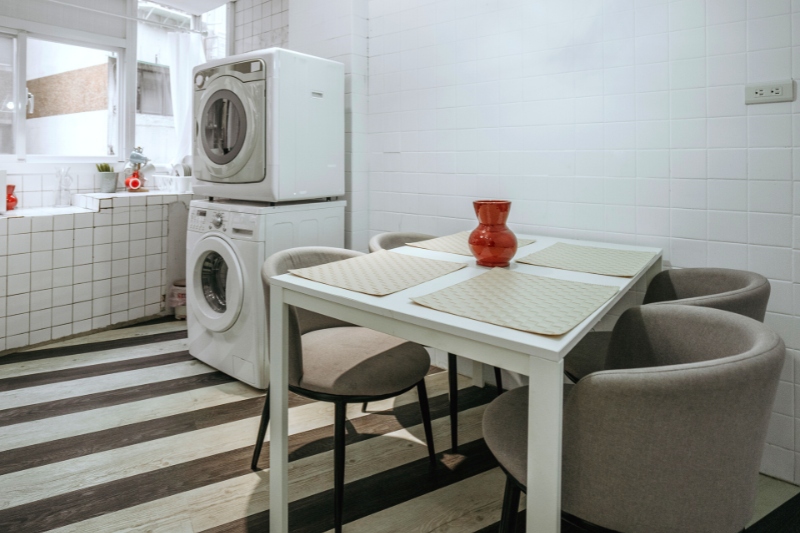
It’s not recommended to have a washing machine in a living space because you don’t usually have the right type of connections in these rooms.
You’d have to get a plumber out to fit the right water inlets and outlets, and an electrician to fit a plug socket. This would likely work out costly for you.
Not to mention the fact that having a cumbersome washer sitting in the living room is an eyesore, it’s noisy, and it’ll take up a lot of space. You could, of course, create a special cupboard for the washing machine, but this will be an added cost.
Putting a Washing Machine Upstairs
A lot of people have decided to forgo the tradition of having a washer in the kitchen or utility room, and are placing their appliances upstairs.
But what are the benefits and drawbacks of keeping a washing machine upstairs?
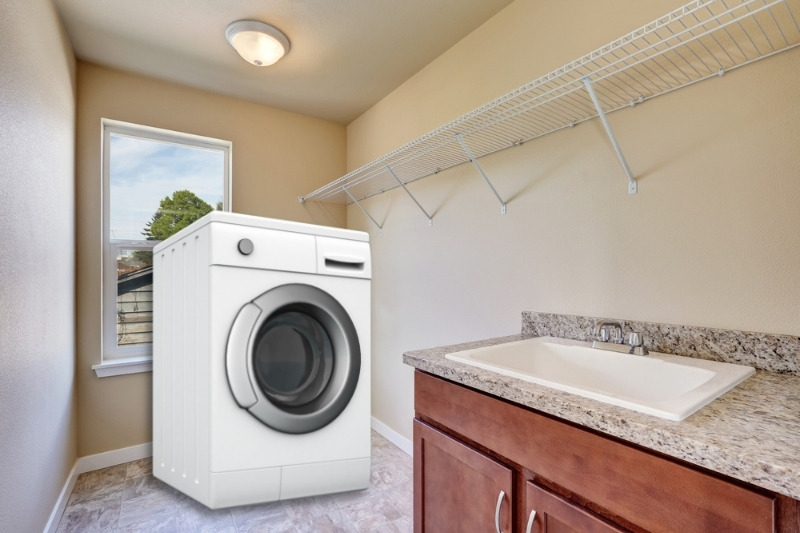
Pros:
- Time saver – You tend to get dressed and changed upstairs, so you can just walk across the landing and deposit the dirty laundry in the machine!
- There’s less walking back and forth, up and down the stairs with your arms full of grotty laundry. You can clean, dry, and store everything whilst being on the same level.
- It’ll give you extra cupboard space downstairs.
Cons:
- You’ll still have to carry some laundry about the place, so you’re not entirely free from this.
- Washing machines can be noisy, and you don’t want to disturb family members or neighbours when they’re trying to sleep.
- How do you get the machine upstairs in the first place? Washing machines are very heavy and you usually need at least two people to move them. Getting this appliance up a set of stairs can be very difficult especially if you don’t use the right tools and technique!
- If the washer leaks, the water could come through the floorboards and affect the ceiling in the room below. This, in turn, could be expensive to repair.
- It’s usually pricey to get the right connections fitted upstairs if they aren’t already there.
Is It Okay to Put a Washing Machine in a Kitchen?
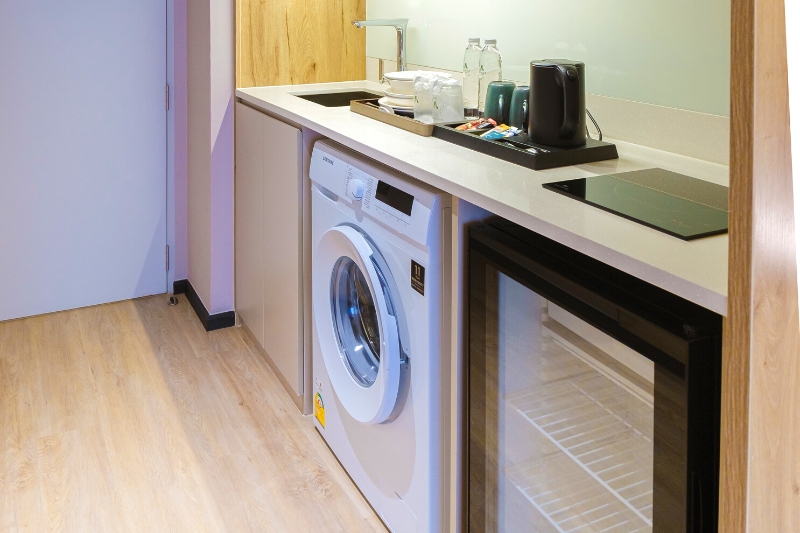
Yes, it is okay to put a washing machine in the kitchen. In fact, this is where a lot of people in the UK keep their washers. This is mainly because the right plumbing outlets are in place, and there’s usually a power socket available nearby, so you can hook the appliance up and start using it.
Can You Keep a Washing Machine in a Cupboard?
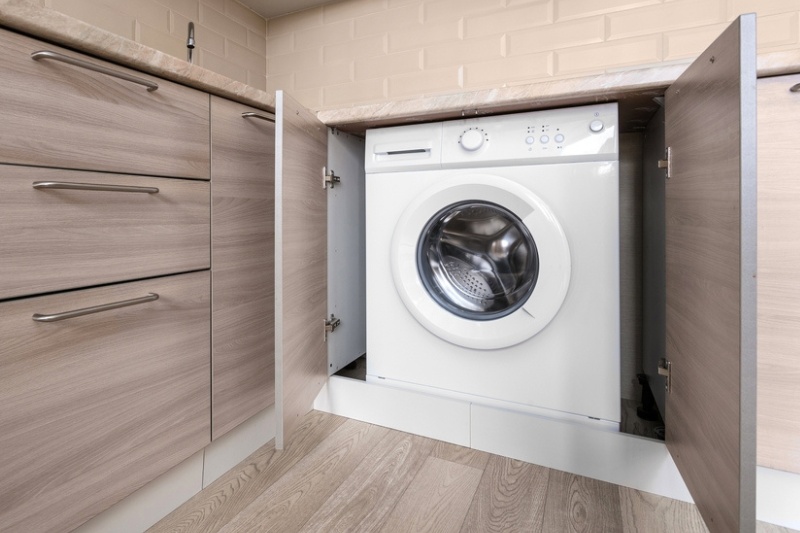
Yes, it is possible to keep a washing machine in a cupboard. Washing machines that are designed to be placed behind a cupboard door are known as integrated washing machines.
They’re normally slightly smaller in size and fit snugly into a kitchen cabinet. A cupboard door usually closes and covers the front of the washing machine, so you’d never know the appliance was there.
You can also put washing machines in regular cupboards around a house. But before you do this you’ve got to make sure that the right plumbing and electrical features are in place.
It’s also important that you ensure plenty of fresh air can get in and out of the cupboard. Otherwise, you’ll end up with mould or damp-related problems.
Just keep in mind that it can be costly to get the right connections fitted in a cupboard.

Bethan has a passion for exploring, reading, cooking and gardening! When she’s not creating culinary delights for her family, she’s concocting potions to keep her house clean!
